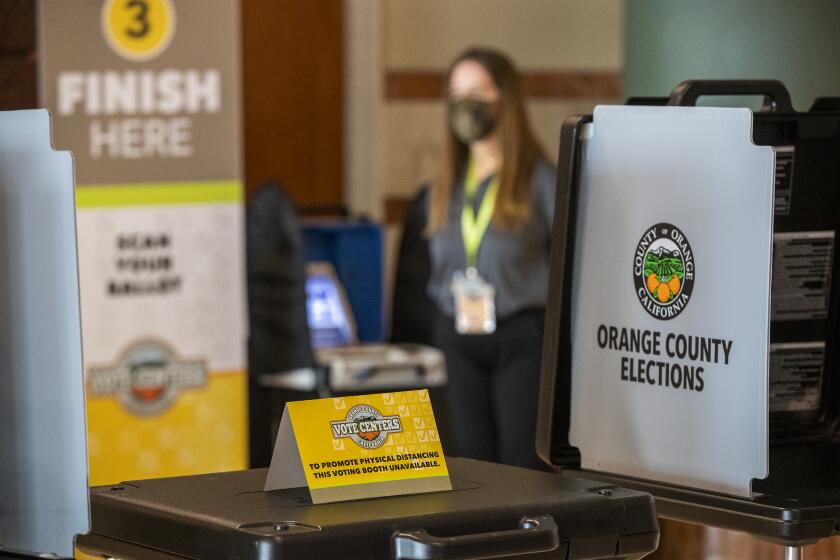Agency’s Surplus Balloons
- Share via
After crying poor and slashing services for more than a year, the Los Angeles County health department this week announced a brief reversal of fortune: a year-end surplus that was $103 million more than expected.
The news touched off a flurry of finger-pointing at the county Hall of Administration, with Supervisor Gloria Molina accusing the department of “funny math” that misled her into voting to lay off health workers and cut programs.
“We make decisions based on these numbers,” Molina said. “It costs people losing their jobs, it costs us closing hospitals.... It’s shocking and appalling to me that we have a department who plays so loosely with these figures to get us to make decisions that are inappropriate on behalf of communities so desperately in need.”
The public drubbing, which went on for almost an hour at Tuesday’s Board of Supervisors meeting, came as health officials protested that -- despite the sudden surge of cash -- their budget projections for future years were bleaker than ever.
Health-care expenses continue to outstrip the money available to pay for them, said county Health Services Director Thomas Garthwaite, who warned of a $768-million deficit by 2007.
But the dips and whirls of Garthwaite’s financial projections left some observers a bit unsettled.
“I’m always amazed,” said Elena Ackel, an attorney with the Legal Aid Foundation of Los Angeles, which had sued the county on behalf of uninsured patients who use public hospitals.
“The fact that they come up with an additional $103 million to their favor makes it hard to take seriously the size of their anticipated deficit in 2007,” she said. “They can’t even predict one year out.”
The county’s mathematical problems reflect a hard reality that has busted many a budget: Forecasting is difficult, especially where economics and politics are concerned.
Witness the state of California, whose projected budget shortfall swelled from $21.1 billion to $38.2 billion in the space of six months. Or consider the federal government, whose estimated $334-billion surplus withered, in less than two years, into a $455-billion deficit.
In Los Angeles County, officials at first assumed that the $3.1-billion Department of Heath Services’ budget would have about $40 million left over when the 2002-03 fiscal year ended June 30. In April, health officials told the Board of Supervisors that they expected to have an additional $82 million at year’s end.
But after the books closed and the final numbers were tallied, they found $103 million more, for a total year-end surplus of $225 million.
Health officials said the windfall came from a variety of legal settlements, the improved collection of insurance payments and the postponement of technology upgrades.
“I don’t believe there’s been any intent to misinform,” Garthwaite told the board. “But I take very seriously the concern you have, and I agree.... We’ll rededicate our efforts to giving you the most accurate data humanly possible.”
Supervisor Zev Yaroslavsky defended the department’s budget maneuvers, saying he prefers caution to optimistic forecasts of riches that don’t materialize.
“I’ll take conservative assumptions over liberal assumptions any day of the week,” he said, “because I’d rather be pleasantly surprised at the end of the year than unpleasantly surprised.”
“It’s responsible planning,” Supervisor Mike Antonovich agreed.
For the last year, the board has been largely united in beating a path toward fiscal stability for the perpetually shaky health department.
The county’s heavy load of uninsured patients, coupled with rising medical costs and dwindling help from Sacramento and Washington, has left its hospitals and clinics bleeding cash. And years of reluctance by supervisors to make tough cuts have only prolonged the pain.
But in January, the board voted to close Rancho Los Amigos National Rehabilitation Center in Downey and cut 100 beds at County-USC Medical Center. Both efforts have since been derailed by a federal court, but the county was able to shed 400 health-care jobs, close 16 clinics and reduce other services, saving an estimated $25 million.
Now comes another politically charged question: what to do with the money. Patients advocates, including Ackel, say some of it should be used to maintain services at Rancho and County-USC. The health department wants to hang onto it to offset projected losses.
But another major budget bump is looming. After the state Legislature approved its spending plan this week, the county’s budget brass came up with another ugly calculation. David Janssen, the county’s chief administrative officer, said the state budget could cost the county as much as $300 million.
The health department’s unexpected cash could help fill that hole. But would Janssen dare to dip into such a roiling pot?
“I might,” he said. “It’s available for dealing with problems.”
More to Read
Sign up for Essential California
The most important California stories and recommendations in your inbox every morning.
You may occasionally receive promotional content from the Los Angeles Times.










